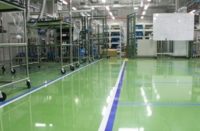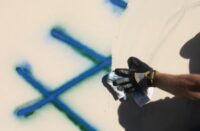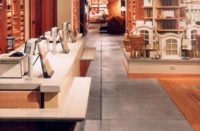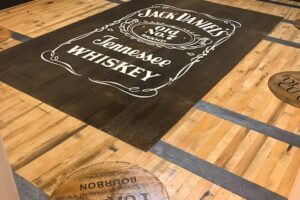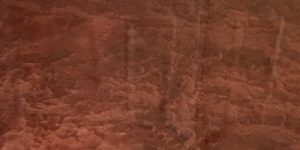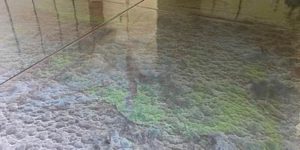
Inspired by the pro bono work done on the Bannister House last year during the Concrete Decor Show in San Diego, Jodi Cain of Quest Building Products began looking for ways she and her fellow employees could use their skills and services to give back to their community in Southern California.
An opportunity soon presented itself, she says, when Quest was asked how to handle a moisture problem at a large warehouse across the street from the Kretus Group, Quest’s sister company that manufactures concrete products, decorative flooring and wall coating products largely targeted to meet California’s strict building materials criteria. “It started out as a casual request for consultation and ended up with us doing way more than what they were asking,” she says.
That “way more” involved donating materials and helping HomeAid Orange County transform a 60-year-old warehouse into a 56-bed emergency family care center with the bulk of the space dedicated to living quarters. HomeAid OC is a 501 (c) 3 nonprofit organization established in 1989 to combat the area’s homelessness, particularly homeless families.
The HomeAid Orange County Family Care Center — which includes a reception and client intake area, snack bar, learning lab, outdoor recreation space, kitchen and dining areas, and bathroom, shower and laundry facilities — has nearly 10,000 square feet of space. Employees and constituents from both Quest and Kretus volunteered to repair, prep and waterproof the existing concrete floor and finish a portion of it with decorative finishes.

On with the coatings
Prior to the coatings, volunteers installed Kretus Poly Joint Filler to repair all cracks and joints throughout the building, with a rapid return to service.
The flooring in the living area, which is configured to house 10-15 families at a time, was waterproofed with Kretus Top Shelf Epoxy MVR-FC (Moisture Vapor Reducer, Fast Cure) to comply with ASTM F3010, the standard practice for two-component resin-based membrane-forming moisture mitigation systems for use under resilient floor coverings.
“It cured in two hours at 89 degrees F,” Cain says, adding another volunteer later carpeted that area.
Instead of staining the concrete separately and then applying the epoxy in the walkways, kitchen, restrooms and laundry facilities, the Quest crew mixed a black Ameripolish stain with Kretus Top Shelf Epoxy and applied both products in one step, Cain says.

“The stained epoxy was something most people hadn’t seen before,” says Tom Caltabiano, business development manager for Quest Building Products, who was among company employees who pitched in and helped. “It’s a really cost-effective option to create a wonderful look. I think it was the center point of entire project.”
At the request of the HomeAid folks, applicators installed a topcoat of Kretus Polyurethane HP (High Performance) with Kretus Anti-Slip Additive over the colored epoxy in these areas. The anti-slip additive particles, she explains, are spherical in shape not jagged so when children fall on the floor, the anti-slip coating won’t scratch their skin.
In the learning lab that serves as the children’s computer room, the crew put down Kretus Dark Blue and White Metallic coating. “From overhead, it looks like the ocean,” Cain says. “The designers at HomeAid are calling it ‘Google Earth.’”
Mix and match
Probably the biggest challenge to the HomeAid project was working around all the other trades involved. Quest/Kretus’ portion of the job was supposed to start in June, but didn’t get underway until July. This made for some very early mornings and some very late nights, says Caltabiano, to make the project’s July 20 dedication ceremony.
“There were many delays in the schedule, which are very common in the construction industry,” he says. “The variety of products in the Kretus line really allowed us to be flexible when accommodating the ever-changing production schedule.”
The Kretus Top Shelf Epoxy line, for example, has one A part but five different B parts rather than the standard one. “You can mix and match the product line,” Caltabiano says. “It helps you dance around the project’s limitations.”

Basically, elaborates Jeremy St. Clair, another volunteer and the general manager/technical director at Kretus Group, “It’s a mix-and-match, 100 percent solids, two-component system. You can mix any Top Shelf resin with any Top Shelf hardener to vary chemical resistance, mil thickness, cure times, moisture vapor reduction and more. The multiple combinations (are designed) to meet changing environmental conditions and your installation requirements.”
One of the upsides of this project, Caltabiano adds, is that it served as a tutorial for some of the companies’ clients. Interested contractors gained some hands-on training experience while giving back to the community through volunteer service.
End results: Priceless
“My favorite part of the project was not even part of the installation,” says St. Clair. “It was during the opening ceremony where I saw a little girl about 6 years old and her older sister get to play in a playhouse that was custom-built for the center. You could see the girls were very tan from being in the sun for long periods. After about 30 minutes she looked up at her mom, and asked if she could sleep in the bed.”
That scenario, he says, “made every minute working on the job worth it. We are so happy to have HomeAid as our neighbors.”
Project at a Glance
Client: HomeAid Orange County
Installers: Quest Building Products and Kretus Group
Most challenging aspect: A very tight schedule and a busy floor
Equipment for surface preparation: Scanmaskin 650 26-inch planetary 230-volt grinder paired with Ermator S36 dust extractor, Metablog W24-230 7-inch hand-held grinder and SPE 9ES 9-inch self-propelled 230-volt shot blaster paired with Ermator S36 dust extractors, and Kohler PRO12.3EFI 12.3kW portable generator
Products used: Top Shelf Epoxy MVR-FC, Poly Joint Filler, Anti-Slip Additive, Polyurethane HP, and Dark Blue and White Metallic, all from Kretus Group; Ameripolish stain
